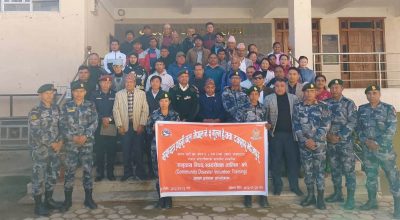
Nawalparasi, Dec 20: Local residents of buffer zone in Nawalpur (Bardaghat-Susta East) have long been facing trouble with the rise in the incidents of wildlife rampage.
Wildlife’s frequent intrusion to the paddy farms caused loss and damage to the farmers in buffer zone. In a bid to avoid wildlife menace in Chitwan National Park’s buffer zone, some local farmers switched over their profession from paddy-farming to fish-keeping.
Devraj Subba, a farmer of Kawaswoti municiplaity-7, Nepal, said they have shifted their profession to fish-keeping to avoid wildlife intrusion and earn up more income. He further said almost every household has possessed fish ponds in the area along the forest border.
He said that most of the people living along the border area of the forest have fish ponds. “Around 70 families here have ponds. With the rise in wildlife rampage, plantation of other crops in the area adjacent to the forest cannot be saved,” he said, adding fish-keeping has turned to be an effective option to the paddy-farming as its income is also good.
Yam Bahadur Nepali, who had been cultivating paddy earlier, has also constructed fish pond later. He said the trend of constructing fish ponds has increased as a livelihood option.
Lately number of fish farmers is increasing in Devchuli, Kawaswoti and Madhyabindu municipalities of the district. The community forests here have also been supporting the construction of fish ponds in the bordering areas of the forest.
Chairman of the forest, Khil Bahadur Gurung said that the Model Buffer Zone Community Forest Users’ Group has been providing support to those who want to keep fish. There are a total of 140 fish ponds in the areas which fall under the Model Buffer Zone Community Forest and Krishnasar Buffer Zone Community Forest.
Chairman Gurung further commented that fish-keeping has also helped mitigate human-wildlife conflict in the area. Fish-keeping profession nearby forest area is expanding of late, he shared.
He said it has also resolved the problem of wildlife ruining crops on the one hand and on the other fish farming business has generated a decent income.
Kawasoti Municipality has been providing grants by declaring the wards as pocket areas as the residents of the buffer zones have been attracted to fish farming. Chief of Agriculture Development Section of Kawasoti Municipality, Shiva Narayan Kumal, said that ward no. 7 and 13 of Kawasoti municipality are being developed as fish pocket areas. “We have started providing necessary subsidies from the municipality as the fish farming area is increasing in the vicinity of the forest and the farmers are also earning good income,” he said.
















